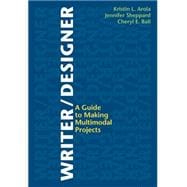
Note: Supplemental materials are not guaranteed with Rental or Used book purchases.
Purchase Benefits
What is included with this book?
Cheryl E Ball is an Associate Professor of Digital Publishing Studies in the English Department at West Virginia University. Her areas of specialization include multimodal composition and editing practices, digital media scholarship, and digital publishing. Since 2006, Ball has been editor of the online, peer-reviewed, open-access journal Kairos: Rhetoric, Technology, and Pedagogy, which exclusively publishes digital media scholarship and is read in 180 countries. She has published articles in a range of rhetoric/composition, technical communication, and media studies journals including Computers and Composition, C&C Online, Fibreculture, Convergence, Programmatic Perspectives, and Technical Communication Quarterly. Her recent books include a scholarly multimedia collection The New Work of Composing (co-edited with Debra Journet and Ryan Trauman, C&C Digital Press) and the print-based RAW: Reading and Writing New Media (co-edited with Jim Kalmbach, Hampton Press).
Introduction for Students
Chapter 1: What are Multimodal Projects?
The Modes, How Do They Work?
[ix] Text, from ix: visualizing composition
Linguistic Mode
Visual Mode
Aural Mode
[e-Pages] Opening Theme, The Colbert Report
[e-Pages] Creative Commons, Wanna Work Together?
Spatial Mode
Gestural Mode
[e-Pages] President Obama Speaking at 9/11 Memorial Service
Understanding Medium, Mode, and Affordances
Case Study: Multimodality in Action
[e-Pages] Interactive map from Recovery.gov
Putting Multimodality to Work as a Writer/Designer
WRITE/DESIGN ASSIGNMENT: Describing Multimodality in Everyday Texts
Chapter 2: Analyzing Multimodal Projects
Rhetoric and Multimodality
Rhetorical Analysis
Audience
[ix] Audience, from ix: visualizing composition
Purpose
[ix] Purpose, from ix: visualizing composition
Context
[ix] Context, from ix: visualizing composition
Author
Genre
Case Study: Analyzing the Rhetorical Situation
Case Study: Analyzing Design Choices
Emphasis
[ix] Emphasis, from ix: visualizing composition
Contrast
[ix] Contrast, from ix: visualizing composition
Organization
[ix] Organization, from ix: visualizing composition
Alignment
[ix] Alignment, from ix: visualizing composition
Proximity
[ix] Proximity, from ix: visualizing composition
Writing and Designing Rhetorically
WRITE/DESIGN ASSIGNMENT: Rhetorical Analysis of Multimodal Texts
Chapter 3: Choosing a Genre and Pitching Your Project
Exploring the What and How
[e-Pages] Maria Andersen, Playing to Learn?
WRITE/DESIGN ASSIGNMENT: Researching your Project Idea
Genre Conventions
[e-Pages] Bush, Games-Based Learning
[e-Pages] Maelia, Using Web-Based Games to Support 21st Century Learning
Case Study: Looking at Genre Conventions
WRITE/DESIGN ASSIGNMENT: Analyzing Genre & Genre Conventions
Pitching Your Project
[e-Pages] Sample Student Pitch Presentation
WRITE/DESIGN ASSIGNMENT: The Pitch
Chapter 4: Working with Multimodal Sources
Finding Credible Sources
Case Study: Multimodal Research Processes
Sources and Assets
WRITE/DESIGN ASSIGNMENT: A Multimodal Annotated Source List, Part I
Ethics of Collecting Sources and Assets
Copyright
Fair Use
Permissions
Creative Commons
WRITE/DESIGN ASSIGNMENT: A Multimodal Annotated Source List, Part 2
Designing Your Citations
Provide Enough Information for Readers
Use a Credible Citation Style for Your Genre
[e-Pages] Classic Movie Credits
WRITE/DESIGN ASSIGNMENT: A Multimodal Annotated Source List, Part 3
Chapter 5: Conceptualizing and Collaborating
But How Do I Make A Multimodal Text?
Case Study: Assessing the Affordances of Web Editors and Image Editors
[e-Pages] Ariel Popp, Life-Based Web Comics
WRITE/DESIGN ASSIGNMENT: Technology Review
Collaborating Effectively
Case Study: Collaborative Composing Strategies
Guidelines for Successful Collaborations
Case Study: Assessing Technologies for Collaboration
WRITE/DESIGN ASSIGNMENT: Group Contract
Proposing to Get it all Done
WRITE/DESIGN ASSIGNMENT: Project Proposal
Organizing and Sharing Assets
WRITE/DESIGN ASSIGNMENT: Creating a Style Guide
Chapter 6: Designing Your Project
Mockups
Case Study: Using Mockups to Refine Ideas and Get Feedback
[e-Pages] Web site mockup for The Kitchen Sync
Storyboards
[e-Pages] Tasha’s storyboards and final video
WRITE/DESIGN ASSIGNMENT: Creating Your Design Concept
The Feedback Loop
WRITE/DESIGN ASSIGNMENT: Getting Feedback
Making Sure You Have What You Need
WRITE/DESIGN ASSIGNMENT: Revisiting Your Assets List
Chapter 7: Revising and Reviewing Your Project
Rough Cut Planning
Mockup/Storyboard
Assets
Timeline
Creating a Rough Cut
WRITE/DESIGN ASSIGNMENT: Rough Cut
Moving From Rough Cut to Rough Draft
WRITE/DESIGN ASSIGNMENT: Rhetorical Situation & Genre Conventions Summary
Getting and Giving Feedback
WRITE/DESIGN ASSIGNMENT: Peer Review
Using Feedback to Revise Your Rough Draft
WRITE/DESIGN ASSIGNMENT: Revise Your Project
Chapter 8: Putting your Project to Work
Finalizing your Project
Who Will Use Your Project?
How/Where Will They Use It?
What’s Your Future Access Plan?
Preserving Projects through Metadata
Sharing Your Final Project
Case Study: Final Report
[e-Pages] Sample Student Final Report
WRITE/DESIGN ASSIGNMENT: Your Final Report
Documenting Your Design Process for Future Users
WRITE/DESIGN ASSIGNMENT: A Documentation Guide
The Afterlife of Multimodal Projects: Privacy and Security
The New copy of this book will include any supplemental materials advertised. Please check the title of the book to determine if it should include any access cards, study guides, lab manuals, CDs, etc.
The Used, Rental and eBook copies of this book are not guaranteed to include any supplemental materials. Typically, only the book itself is included. This is true even if the title states it includes any access cards, study guides, lab manuals, CDs, etc.